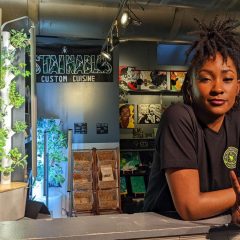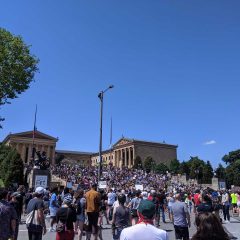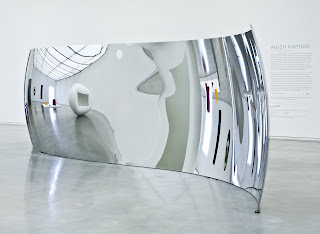
Anish Kapoor, S-Curve, 2006, Polished steel, 85 1/4 x 384 x 48 in. Courtesy Regen Projects, Los Angeles. Photo: John Kennard.
I was in Boston last month for a college reunion (my first; it took me decades to attend one) and managed to fit in two important institutions devoted to contemporary art on my way in from the airport. First was the Institute of Contemporary Art in its prize-winning new building by Diller Scofidio + Renfro; what they’ve given up in terms of walk-in traffic at their previous Back Bay location is made up for in harbor views, although the site’s more obvious for a seafood restaurant (one is just next door) than for a museum. The ICA’s cafe, of course, has smashing views as well as better than museum-average food. The really good news for out-of-towners is its proximity to the airport – about seven minutes’ ride on the MTA’s silver line (which is actually a bus). If you’ve a two-hour layover in Boston, you can easily manage a visit.
The major exhibit was Anish Kapoor: Past, Present, Future: fourteen pieces completed since 1980, running through September 7. Kapoor’s a sculptor who continues to get better and better. His early work involved seductive interior spaces that glowed with the high-keyed intensity of unbound pigments, and one wondered where he’d take it. Big, for one; and he pulls it off, as anyone knows who’s seen his extraordinary and extraordinarily popular Cloud Gate (2004-06) in Chicago. He’s also continued to work with materials that have a mysterious beauty even though they’re no more esoteric than acrylic, resin, wax and stainless steel.
I entered the exhibition to see my own reflection in S-Curve (2006, see above), a piece rather like a slice of a Serra torqued ellipse made of mirrors (actually stainless steel), only these were fun-house mirrors that variously contorted whatever they reflected. Sounds corny, but it wasn’t. To the left was untitled (2007), a translucent acrylic cube of approximately one meter which contained a suspended form – a void, really – that resembled an unknown marine creature somewhat jellyfish-like. Again it was of a magical beauty and a quiet restraint, a delicate and highly detailed sculpture made of nothingness, set within a minimalist cube
Further clockwise Past, Present, Future (2006) occupied a large part of the gallery’s end wall. It was a quarter of a sphere positioned to imply that half of it lay below-ground and the remaining quarter was behind the wall. It was covered with red wax and bisected by a thick slab of iron. It took some time to realize that the sphere actually did continue behind the wall, for it turned slowly back and forth leaving a messy accumulation of wax on the wall as the iron piece caught the wax and spread it rather like cake icing.
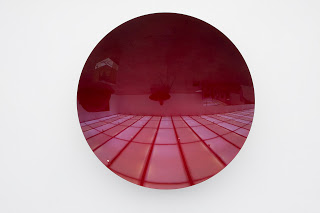
One of my favorite pieces, When I am Pregnant (1992), appeared to be a protrusion in one of the walls, its shape exactly replicating a pregnant woman’s belly. It was set so imperceptibly into the wall that the wall itself appeared to be gestating. Kapoor has a poetic genius for creating organic forms, colors, and reflections that transport his viewers back to the innocence of early childhood, when the entire world was a source of wonder. It’s a vision I’m always happy to recapture.
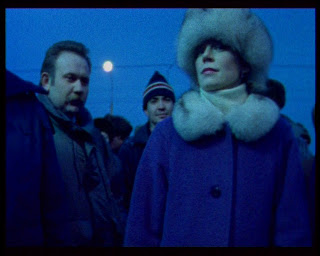
Chantal Ackerman still from D’est: Au bord de la fiction (From the East: Bordering on Fiction), 1995
The List Visual Art Center at MIT really should be better known; highly respected among art professionals for the quality of its programming over several decades, it’s also renowned within the public art field as a rare example of successful collaboration between an architect and artists – in this case I. M. Pei working with Kenneth Noland, Richard Fleischer and Scott Burden. It’s a bit hidden but of easy access via the MTA’s red line and was showing Chantal Ackerman; Moving Through Time and Space (through July 6, it was organized collaboratively by the List, the Blaffer Gallery of the University of Houston, Contemporary Art Museum St. Louis and Miami Art Central/Miami Art Museum), which consisted of five projects by the Belgian artist best known within the film world. It would be worth seeing if only for the first work: D’est: Au bord de la fiction (From the East: Bordering on Fiction), 1995, which I think is one of the most important artworks of the last couple of decades.
The multi-part installation (two parts of which were shown in the traveling exhibition) evolved out of Ackerman’s documentary film, D’est, which traverses an Eastern Europe reinventing itself after the dissolution of the USSR. Ackerman has broken up the film and distributed it across 24 video monitors set up as triptychs and arranged so that one can see up to 14 or 15 at a time. There is no narration although there’s a certain amount of ambient sound. Ackerman’s hypnotic camerawork makes distinctive use of extended slow pans which follow figures, some waiting, others walking, as they progress through the changing seasons outdoors or through transitional indoor public spaces such as train stations; the figures progress through time and history in front of us. These are periodically punctuated by still camera views, mostly of a single woman in interiors. In other settings the work has been shown preceded by a room with a single monitor playing the entire film (as it was in 1995 at 7 museums in Europe and the U.S., I saw it at the Jewish Museum, New York ).
The second room has a single video monitor with a scene of the most minimal of activity: a Moscow street at night that slowly fades to a black void. A woman is narrating and it slowly becomes apparent that it is Ackerman herself discussing her original ideas about the film and reading from the Book of Exodus in both Hebrew and English. It becomes clear that the work, with its images of the everyday and of individuals and peoples in continual movement, exodus, displacement, is also a personal story; that Ackerman, the daughter of a survivor of the Holocaust, returned to Eastern Europe in part to capture her mother’s past. But the installation evokes a much more generalized notion of our living in a world of constant movement and exile, of peoples and individuals dealing with the everyday and enduring, despite the pain.
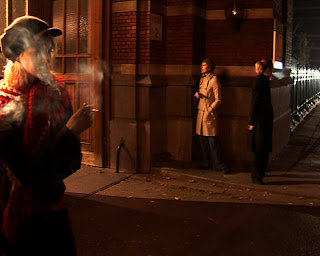
Chantal Ackerman still from Les Femmes d’Anvers en Novembre (Women in Antwerp in November), 2002
Exile and the recovery of painful history are themes across Ackerman’s work. The exhibition includes the film Sud (South), 1999, which began as an exploration of the Southern U.S. which Ackerman knew from the novels of Faulkner and others and changed when she came upon the site of a recent racial murder in Texas. De l’autre Cote (From the Other Side), 2002,is a meditation about illegal immigrants at the Texas/Arizona border. Les Femmes d’Anvers en Novembre (Women in Antwerp in November), 2002, intercuts what appear to be excerpts of various narratives linked by the imagery of women smoking and La-bas (Down There), 2006, the only piece screened in a conventional theater space, evolved from her stay in Tel Aviv.



